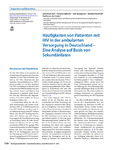2020-09-24Zeitschriftenartikel
Häufigkeiten von Patienten mit HIV in der ambulanten Versorgung in Deutschland – Eine Analyse auf Basis von Sekundärdaten
Kurch-Bek, Diana
Gallowitz, Christian
Baumgarten, Axel
Tenckhoff, Bernhard
an der Heiden, Matthias
Hintergrund
Jährlich veröffentlicht das Robert Koch-Institut (RKI) die Zahl der HIV-Erstdiagnosen und die Gesamtzahl von Menschen mit HIV-Diagnosen in Deutschland. Eine Bestimmung mithilfe von Sekundärdaten erfolgte bislang nur mit Arzneimitteldaten.
Ziel der Arbeit
Auf Basis von Leistungsdaten wird die Anzahl von erstmals ambulant versorgten HIV-Patienten unter gesetzlich Krankenversicherten bestimmt sowie die Gesamtzahl von GKV-Patienten mit HIV in der ambulanten Versorgung. HIV-Testraten für Deutschland werden untersucht.
Material und Methoden
Die Leistungsdaten der gesetzlich Krankenversicherten aus dem ambulanten kollektivvertraglichen Sektor (kurz: ambulante Versorgung) liegen für den Beobachtungszeitraum 2009 bis 2018 vor. Für die Jahre 2011 bis 2017 wurden Jahreskohorten auf Basis von Patientenentitäten gebildet und hinsichtlich der HIV-Diagnose, der HIV-spezifischen Betreuungsleistungen und HIV-Testraten untersucht.
Ergebnisse
Jährlich werden etwa 6000 Patienten mit HIV erstmals ambulant versorgt. Die Gesamtzahl der ambulant versorgten Patienten mit HIV betrug im Jahr 2011 etwa 59.300 (0,106 %) und stieg zum Jahr 2017 auf etwa 80.800 (0,141 %) an. Der durchschnittliche Anstieg der Gesamtzahl um etwa 3600 Patienten pro Jahr lag damit deutlich unter der geschätzten Zahl jährlich neu versorgter Patienten.
Schlussfolgerung
Die Ergebnisse können erste Anhaltspunkte zur ambulanten Versorgung von Patienten mit HIV geben. Die vorliegenden Sekundärdaten geben die Möglichkeit, eine weitere epidemiologische Datenquelle zur bevölkerungsbezogenen Darstellung der administrativen Prävalenz von HIV zu erschließen. Es besteht Forschungsbedarf zu Patienten, welche erstmals ambulante Versorgung in Anspruch nehmen, um die Überrepräsentativität zu klären. Background
The Robert Koch Institute (RKI) annually publishes an estimate of the number of new HIV diagnoses and the total number of people diagnosed with HIV in Germany. So far, only medication prescription data have served as secondary data as a basis for such estimates.
Objectives
In this study, we used billing data from the outpatient sector to estimate the number of patients with newly diagnosed HIV, the overall number of patients with HIV, and the HIV test rates in those with statutory health insurance in Germany.
Materials and methods
We analyzed billing data from the outpatient sector for all persons covered by statutory health insurance between 2009 and 2018. We designed annual cohorts of patient for the years 2011 to 2017 and analyzed the number of HIV diagnoses, the number of HIV-related care services, and HIV testing rates.
Results
Every year, about 6000 new patients with HIV are treated in outpatient care. The total number of patients with HIV in 2011 was about 59,300 (0.106%), which increased to 80,800 (0.141%) in 2017. The average increase in the total number of patients per year of about 3600 was significantly below the estimated number of newly treated patients for each year.
Conclusion
The results may provide an indication of patients receiving HIV care in the outpatient sector. The secondary data provide the possibility of developing another epidemiological data source for population-based representation of the administrative prevalence of HIV. To clarify over-representation, there is a need for further research on patients who are using outpatient care for the first time.

